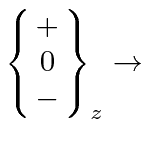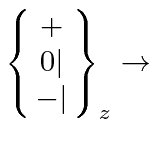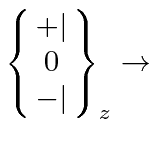Next: Rotation operators for * Up: Operators Matrices and Spin Previous: An System in a Contents
A beam of atoms can be split into the eigenstates of
![]() with a Stern-Gerlach apparatus.
A magnetic moment is associated with angular momentum.
with a Stern-Gerlach apparatus.
A magnetic moment is associated with angular momentum.



A magnet with a strong gradient to the field is shown below.

In the Stern-Gerlach experiment, a beam of atoms (assume
![]() )
is sent into a magnet with a strong field gradient.
The atoms come from an oven through some collimator to form a beam.
The beam is said to be unpolarized since the three m states are equally likely no particular state has been prepared.
An unpolarized,
)
is sent into a magnet with a strong field gradient.
The atoms come from an oven through some collimator to form a beam.
The beam is said to be unpolarized since the three m states are equally likely no particular state has been prepared.
An unpolarized,
![]() beam of atoms will be split into the three beams (of equal intensity)
corresponding to the different eigenvalues of
beam of atoms will be split into the three beams (of equal intensity)
corresponding to the different eigenvalues of
![]() .
.

 state.
state.
We can make a fancy Stern-Gerlach apparatus which puts the beam back together as shown below.


We can use this apparatus to prepare an eigenstate.
The apparatus below picks out the
![]() state
state



An apparatus which blocks both the + and - beams



Similarly, an apparatus with no blocking could be written as the sum of the three projection operators.

If we block only the
![]() beam, the apparatus would be represented by
beam, the apparatus would be represented by

* Example:
A series of Stern-Gerlachs.*
Jim Branson 2013-04-22